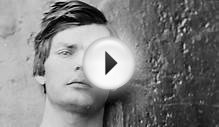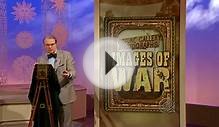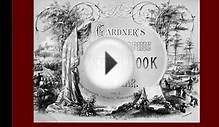
|
Civil War-era photo of the north façade of the Smithsonian Castle. (Image courtesy of Smithsonian Institution Archives) |
The Henry family on the grounds of the Smithsonian, about 1865. (Photograph by Titian Ramsay Peale; Reproduction courtesy of Smithsonian Institution Archives) |
The Castle escaped harm during the Civil War, but in January 1865 experienced a fire on the third floor resulting in structural damage to the building, and loss of collections, including many items owned by James Smithson and records of Secretary Henry’s scientific research. (Hand-tinted photograph by Alexander Gardner; Reproduction courtesy of Smithsonian Institution Archives)
The art of taking pictures of events as they occurred predates the Civil War by many years. Photographic artists in the 1850s made daguerreotypes of lively streets, burning buildings, and people engaged in their various professions. Daguerreotypes were not easily reproducible, however, and few people actually saw them. This changed, however with the invention of the wet plate collodion process—glass plate images could now be reproduced on paper by the thousands. With this new technology, the Civil War would be brought into the homes of Americans like no event before it.
|
This early “news photo” from 1853 shows Joseph Avery stranded in the rapids above Niagara Falls, shortly before plunging to his death. (Daguerreotype, unknown photographer; Image courtesy of Library of Congress) |
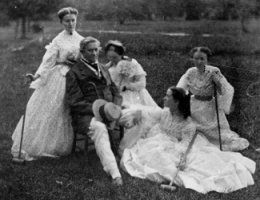 |
Specialized cameras and lenses allowed photographers to record and then print multiple pictures at the same time. Eight small card photographs of Union General George Stoneman, pictured here, could be printed at once. (Image courtesy of National Archives) |
Ambrotypes and Tintypes
The wet collodion process generated both ambrotypes and tintypes. Why a consumer selected one over the other might depend on availability, cost, and preference. The ambrotype, a unique image created by darkening the back of a glass plate negative, would be cased. The tintype, collodion on an iron plate, was also a unique image but with more flexibility as to how it was mounted. It could be cased, placed in jewelry or campaign buttons, or slipped into albums.
Civil War-era four lens tintype camera. (Image courtesy of Smithsonian Institution, National Museum of American History)
Stereoviews
Stereoviews offered three-dimensional photographic depictions of the war alongside explanatory captions or text. Stereoviews were an important means of gathering information. Not only did the cards themselves offer pictures and words, but families could share their ideas and views of the world with one another. The various designs and ornate holders reveal that the stereoviewing experience was a recreational activity and the viewers themselves were meant to be incorporated in the décor of one’s home.
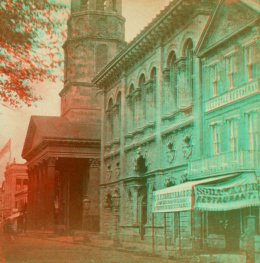 Stereoview of Sir David Brewster and his family looking at stereos. (Unknown photographer; Image courtesy of National Museum of American History)
Stereoview of Sir David Brewster and his family looking at stereos. (Unknown photographer; Image courtesy of National Museum of American History)
“Mr. Brady has done something to bring home to us the terrible reality and earnestness of war. If he has not brought bodies and laid them in our dooryards and along the streets, he has done something very like it.”—New York Times, October 1862, regarding Mathew Brady’s The Dead of Antietam photographs.
|
After Confederate troops burned the strategically important rail junction at Manassas in March 1862, Northern photographers secured dozens of images, including this one, in the wake of the retreating Southerners. (Albumen print by Alexander Gardner; Image courtesy of Bob Zeller Collection) |
During the Battle of Antietam, September 17, 1862, this barn was serving as a Confederate field hospital when it was struck by Union artillery fire. Only a few of the wounded were rescued from the burning building in time. (Albumen print by Alexander Gardner; Image courtesy of Bob Zeller Collection) |
Photos of young dead soldiers in and around the trenches at Petersburg did not reach the public until after the Civil War had ended. Photographer T.C. Roche managed to illustrate the horror of the conflict only after it was over. (Image courtesy of Garry Adelman Collection)
Negatives printed on glass plates allow for an unexpected and astounding level of detail. Look closely at the two photographs above and you will see:
By 1861, more than 6, 000 professional photographers were operating across the nation. Most stayed near cities and towns, content with the steady business of photographing the customers who came through their doors. Only a handful had the equipment, expertise, or desire to actually take pictures on battlefields.
Famed photographer Mathew Brady tried but failed to secure photos of the war’s first great battle—Bull Run, July 21, 1861. However, in the following years, Brady and others pushed the bar ever upward, securing pictures of battlefield carnage and even of actual combat.

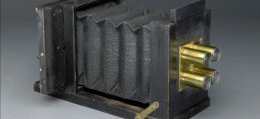
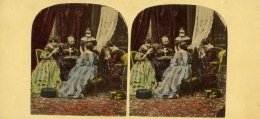
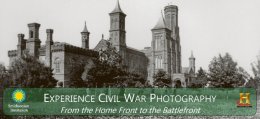
YOU MIGHT ALSO LIKE
